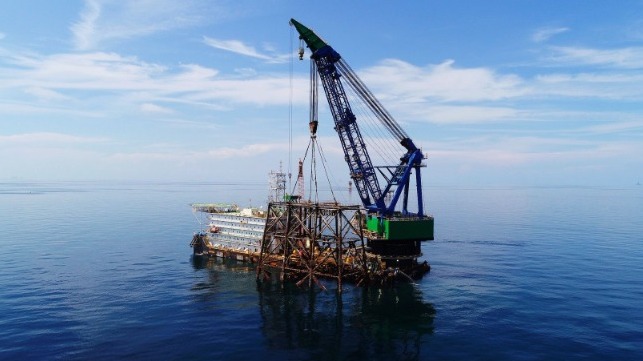OMSA Releases First Report of Jones Act Violations in U.S. Gulf

The Offshore Marine Service Association (OMSA), the industry organization for America's offshore vessel operators, has released its first allegation of a Jones Act violation since the launch of its "enforcement" campaign in the Gulf of Mexico.
To highlight alleged foreign infringment on U.S. coastwise trade rules, OMSA fields a one-of-a-kind patrol vessel, the Jones Act Enforcer. This 150-foot crewboat is tasked with tracking down and photographing foreign-flagged ships that are engaged in Jones Act transport, which is legally reserved for U.S.-built, U.S.-crewed, U.S.-flagged vessels.
OMSA's first report concerns a Chinese-built, Vanuatu-flagged crane barge named Epic Hedron (also known as Triton Hedron, DB Hedron), which was allegedly transporting cargo between U.S. points off the coast of Louisiana. The violation was not spotted by Jones Act Enforcer; instead, OMSA received a tipoff from an industry stakeholder about the vessel operator's own LinkedIn accounts. Upon review, those accounts appeared to show the Chinese-built Epic Hedron carrying and transporting objects that would be classified under the Jones Act as "cargo," with captions clearly describing the nature of the activity.
“In this report, we’ve detailed how a company—by their own admission—used a Chinese-built vessel to transport cargo. That's illegal. Not to mention the vessel they are using has a record of failing Coast Guard inspections," said OMSA President Aaron Smith.
Epic Hedron is a derrick barge with a heavy-lift crane that is capable of lifting large pieces of equipment. In the report, OMSA asserts that the barge used its crane to pick up old oil platform jackets weighing thousands of tons; transported the jackets suspended in the air on multi-mile trips; and delivered them to designated reefing locations for disposal.
"The Epic Hedron could have placed each jacket onto a coastwise-qualified barge, towed by a coastwise-qualified tug, to provide a Jones Act compliant means of transport. Instead, the vessel operator chose to repeatedly transport jackets on the vessel’s hook. These activities prevented the employment of a U.S. shipyard workers and mariners," OMSA wrote in a letter to the U.S. Coast Guard and Customs and Border Protection.
OMSA asserts that the crane barge's movements during the time period in question are difficult to determine because it appears to have turned off its AIS transponder. "[Epic Hedron] has not consistently reported a position on AIS since it left Port Fourchon, Louisiana on June 23," the organization claimed. "However, prior to that time, the vessel’s AIS was engaged as it sat in a navigable waterway in Port Fourchon."
Satellite AIS records provided by Pole Star confirm long gaps in Epic Hedron's AIS transmissions. The data appear to show her departing Port Fourchon in May and again in June. Transmissions from the crane barge were rarely detected by Pole Star's AIS data service provider during the periods when she was under way in the Gulf of Mexico. Her last transmission was received on June 30. AIS transmission is not required for non-self-propelled barges like Epic Hedron, but OMSA has asked the Coast Guard to change its rules to ensure that large crane vessels must broadcast their positions.
